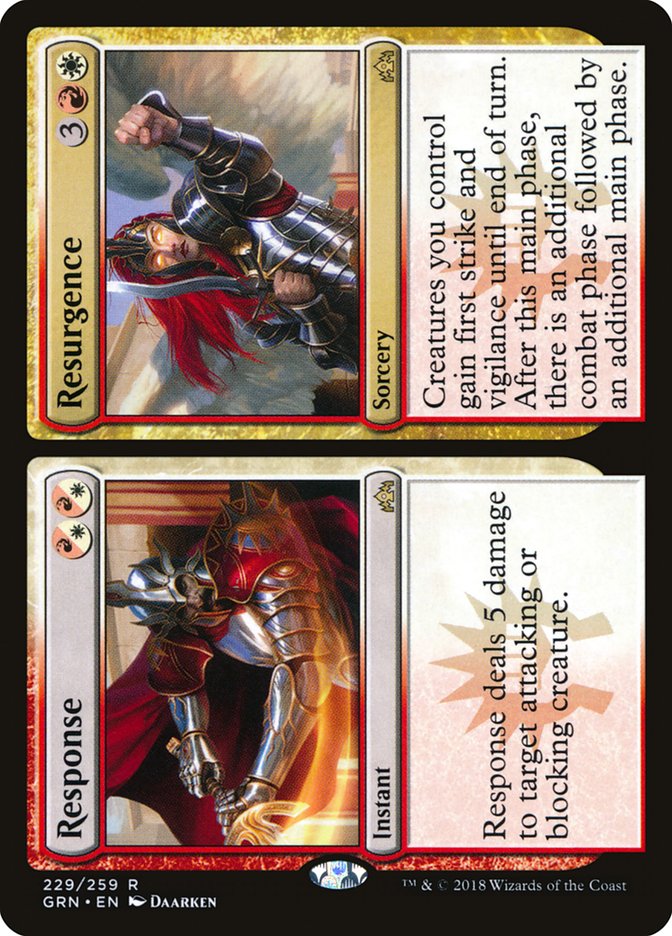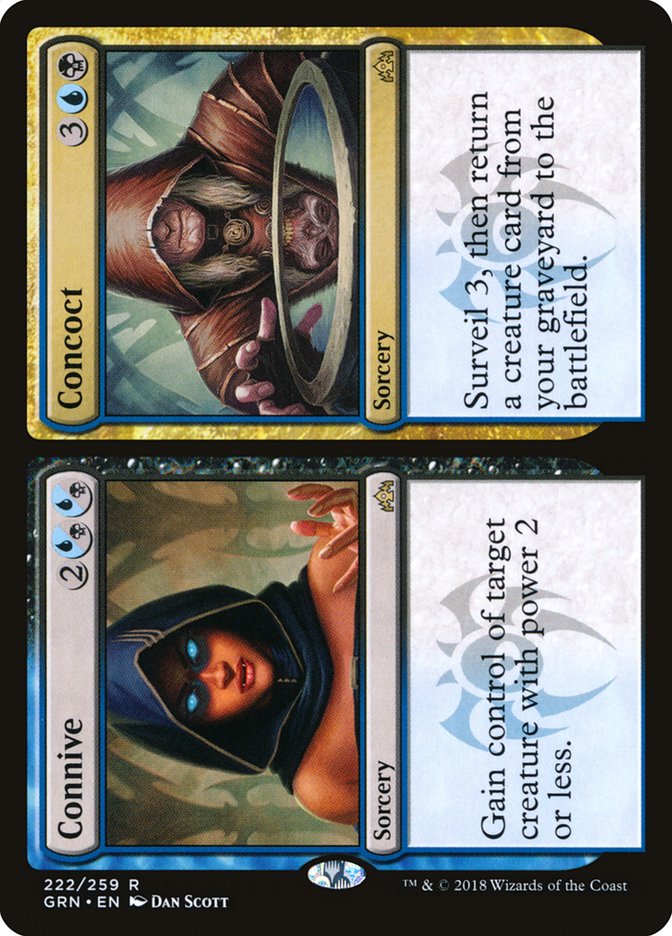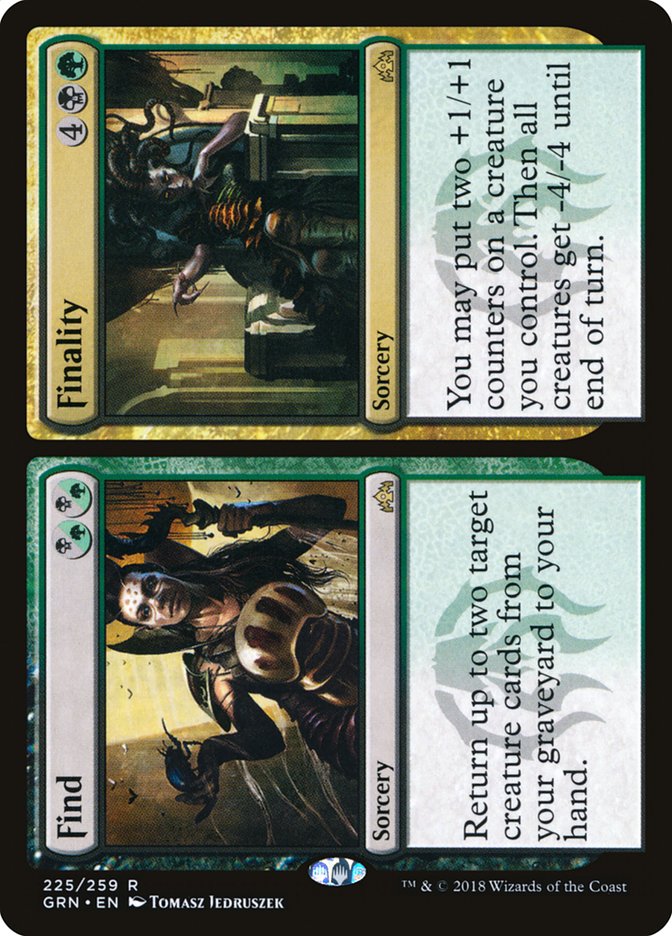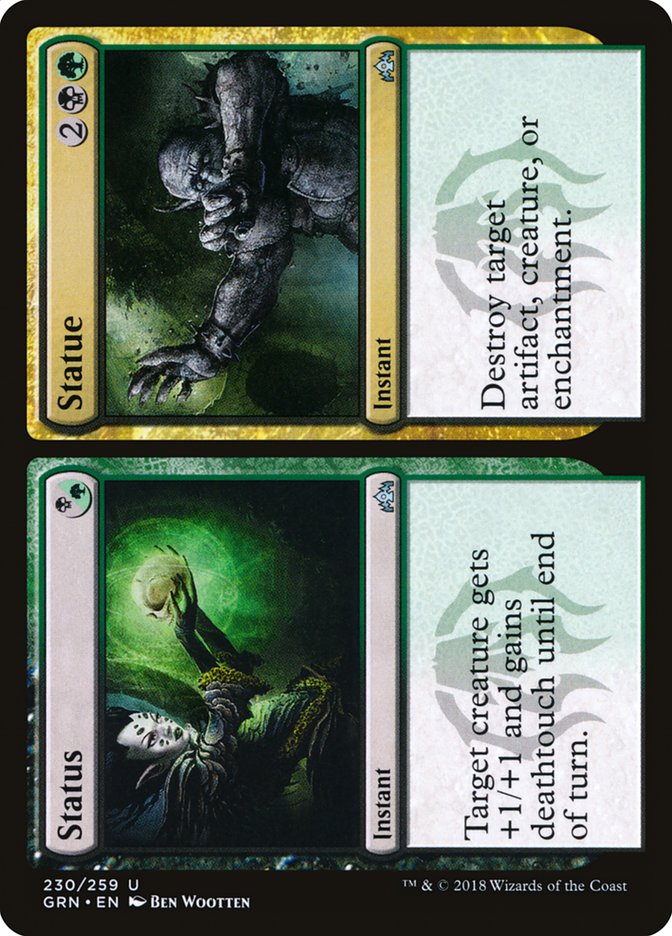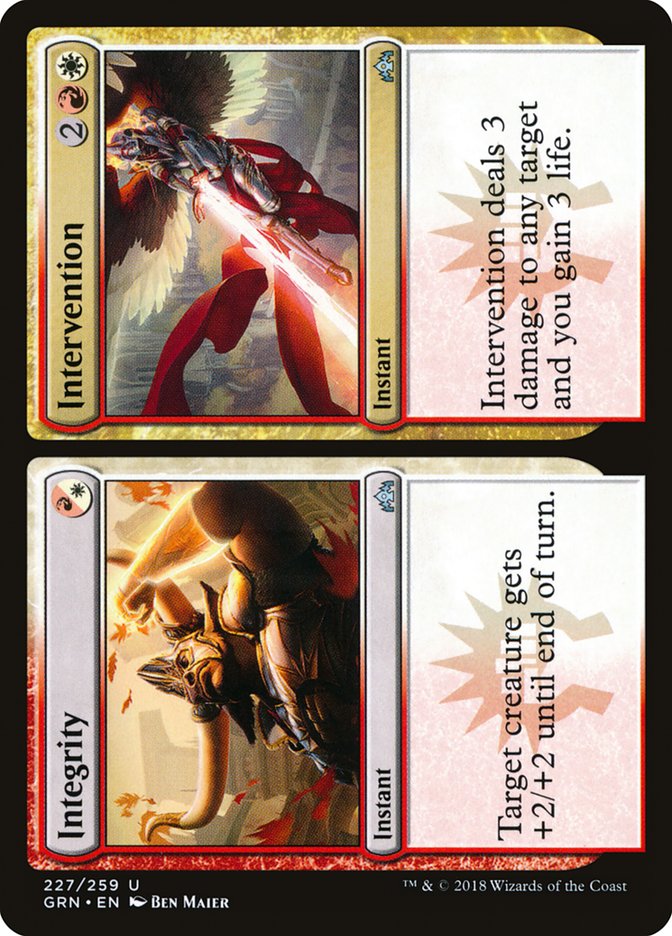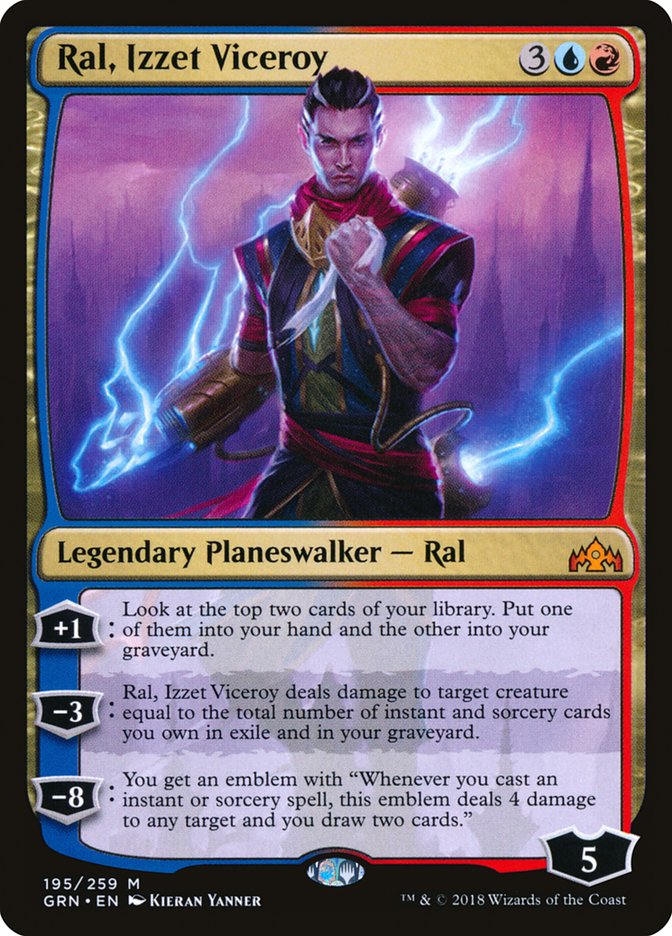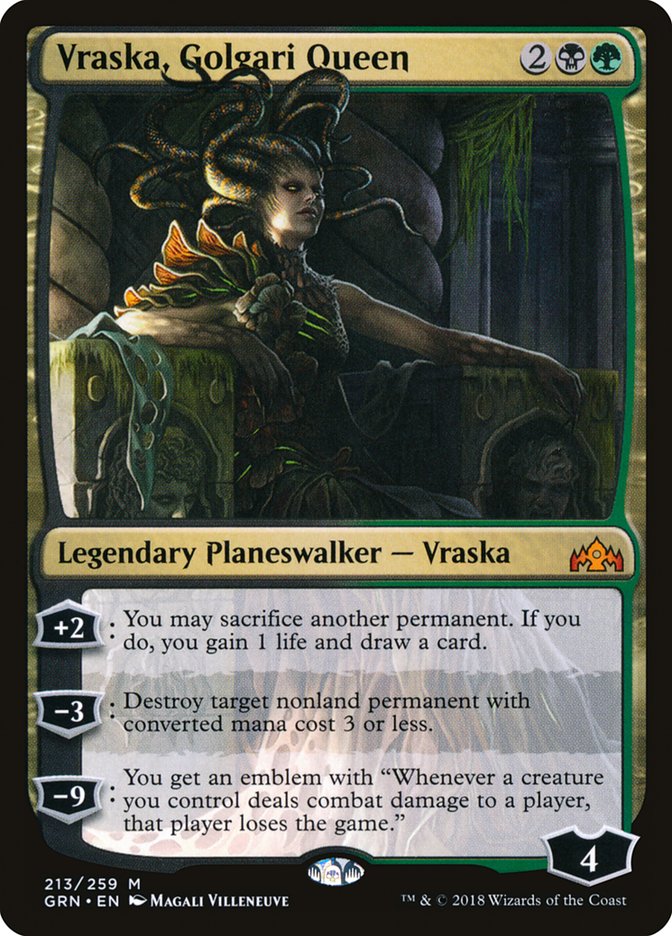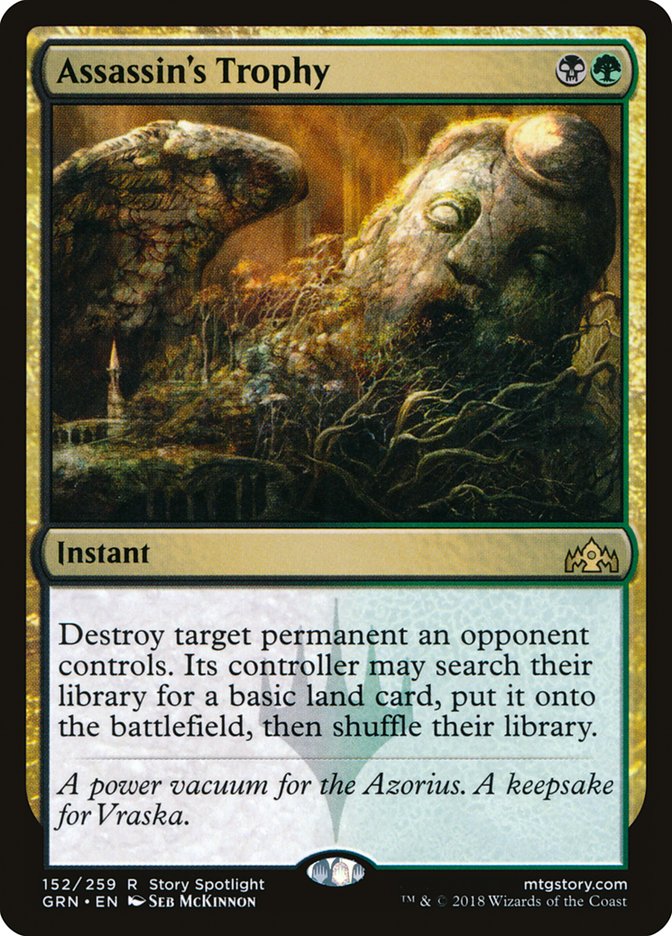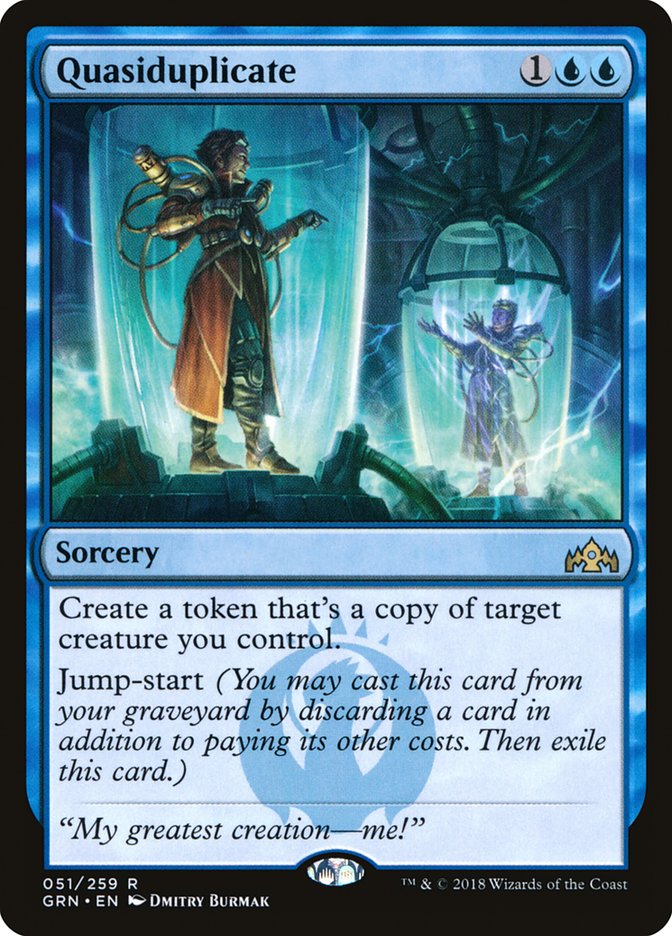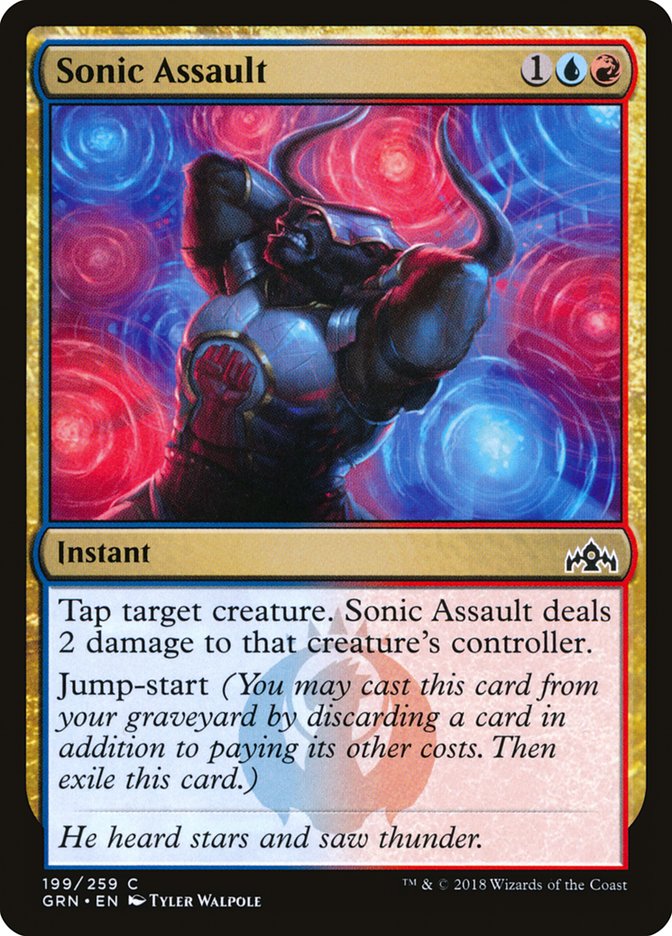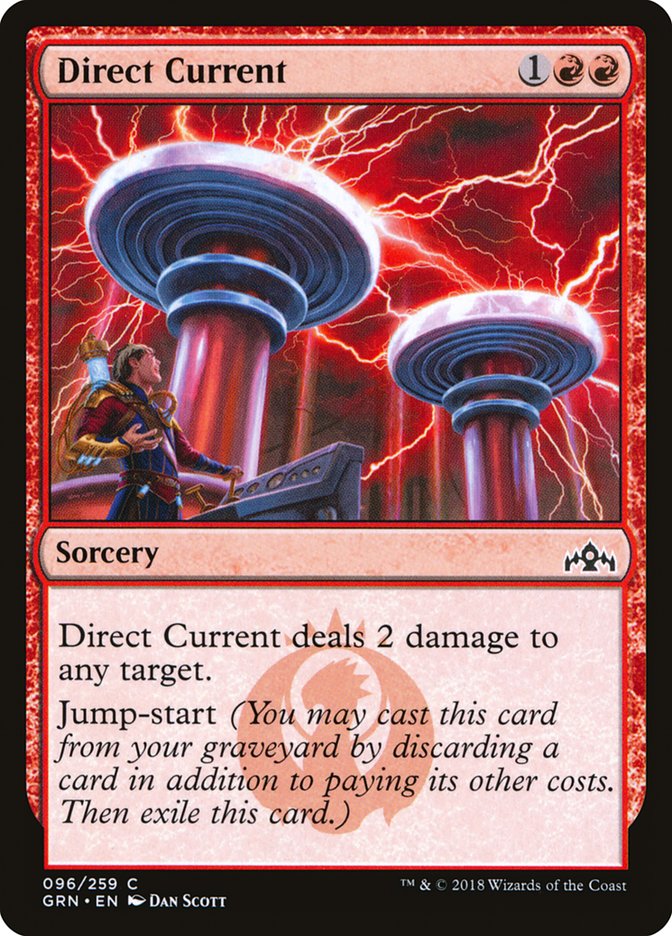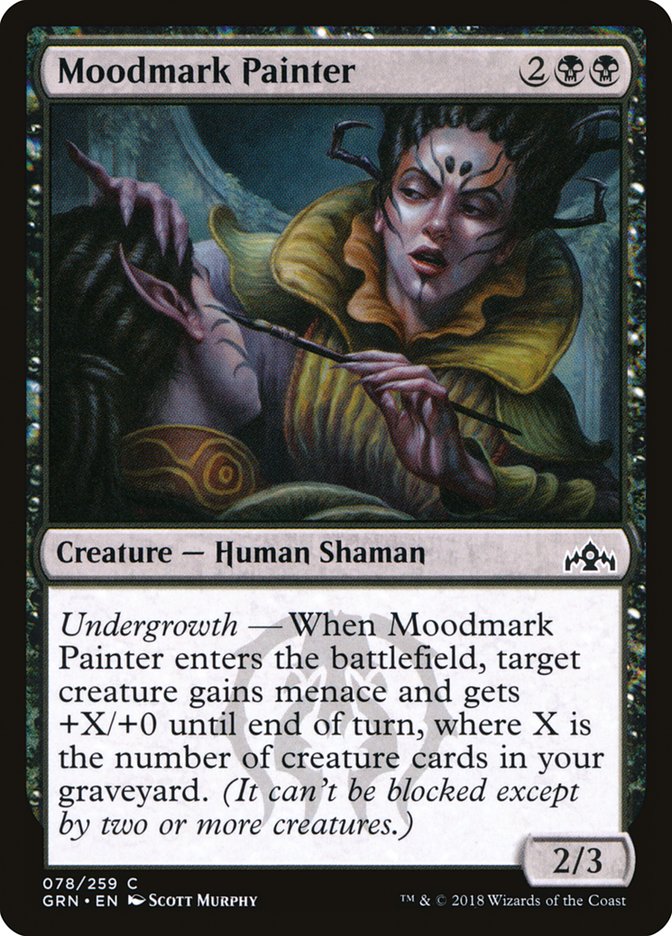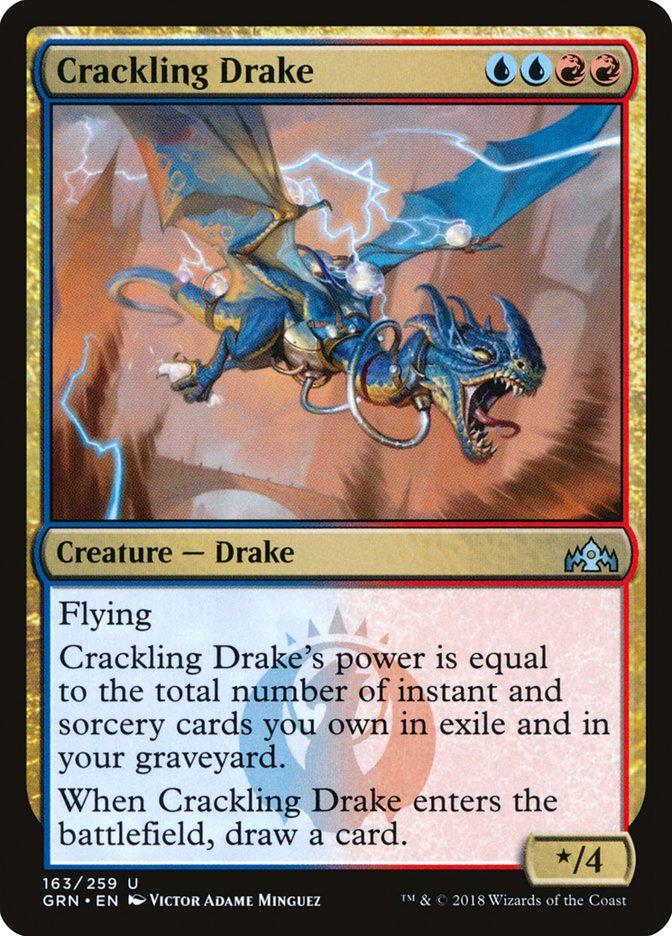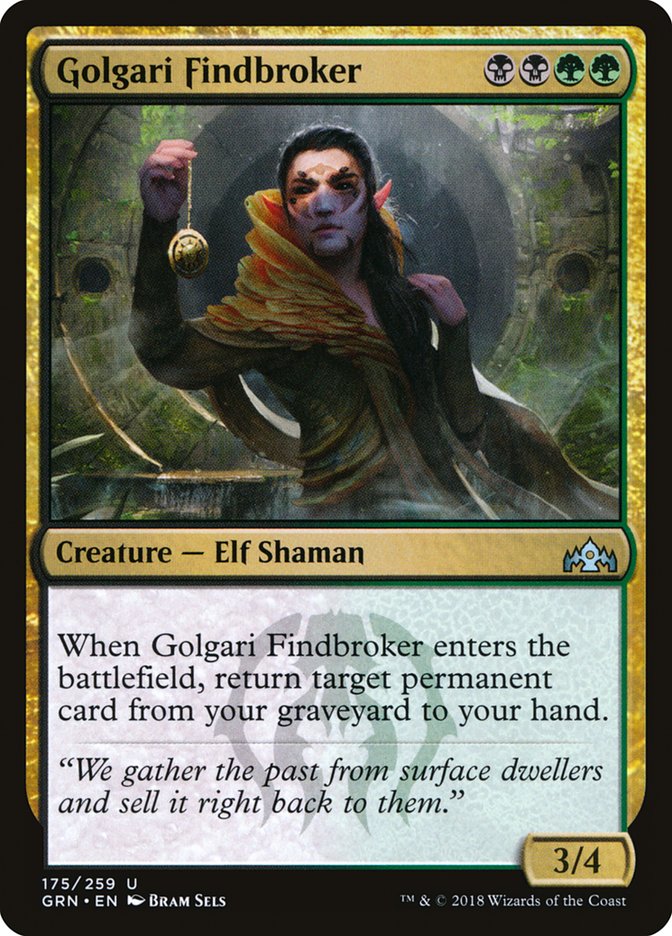Welcome to another edition of
Fact or Fiction
! Today, Bryan Gottlieb, Ari Lax, and Sam Black are here to render
their verdicts on five statements about
Guilds of Ravnica preview season. Don’t forget to vote for the winner at the end!
1. The Guilds of Ravnica split cards are rather
underwhelming and won’t see much Constructed play.
Bryan Gottlieb: Fiction
. As I write this, eight of presumably ten split cards have been revealed.
I expect two to see significant play, and four others have a reasonable
chance of getting some run in Guilds of Ravnica Standard. This is
a fantastic conversion rate for a cycle of cards.
Early musings by my fellow authors suggest that we’re due for a massive
slowdown in Standard, with a high probability of midrange decks taking a
large percentage share of the initial metagame. In this environment, Find
is apt to be a key card, allowing these midrange decks to simultaneously
grind and control the battlefield.
While it may take an additional set to make the mana work, I’m a believer
in the Status Goblin Chainwhirler combo. It helps that Statue is just a
fine piece of unconditional removal that you will be happy to draw in the
lategame even in the absence of any Chainwhirler-based shenanigans.
Response, Expansion, Connive, and Integrity round out the list of perfectly
reasonable split cards. While these cards aren’t necessarily Standard
all-stars, they’re all versatile enough that I can see them making
occasional appearances at top tables. Expansion could even see a little
Modern action as a crazy counterspell/ritual/removal spell/win-condition
split card in Storm!
Ari Lax: Fiction.
Connive alone makes this Fiction. It’s a very reasonable Control Magic,
especially once you account for it taking Aurelia, Exemplar of Justice and
Legion Warboss. Then some percentage of games where you Search for Azcanta
and mill Chromium, the Mutable or whatever giant fatty finisher your
control deck opts for it turns into a five-mana win the game.
I think all five of the rares are going to make a reasonable splash.
Response is a fine removal spell that lets you clock in with midrange
finishers for quick lethal, Find is just an absurdly good rate for Dutiful
Return with upside, Expansion is kind of a Dispel in counter mirrors that
flips into a finisher lategame, and Assurance is just a good rate for six
flash power and a fine trick.
If this was just the uncommons, you might have a point until Status teams
up with Goblin Chainwhirler, but Integrity and Invert both look interesting
enough to see play in some specific shell. None of these are super flashy
must plays, but what split cards ever have been? The choice of two solid
options has always been more than enough.
Sam Black: Fiction.
Split cards exist largely as utility cards and role players, and these are
largely at the perfect power level; none of them are quite good enough to
see play without the other half, but most of them have a cheap half and an
expensive half, which is really valuable.
The gimmick here is to cast Status on Goblin Chainwhirler in response to
the trigger to create a one-sided sweeper. This is fairly easy to pull off
despite Goblin Chainwhirler’s RRR cost because you can use both green and
black duals to help and you only need to find one or the other, and playing
both means that some portion of the time, you’ll be able to cast Statue.
Statue is an extremely versatile removal spell. It’s one more mana than
Putrefy or Mortify, but those were good cards. This is a lot worse than
Utter End, but even when you’re not playing Goblin Chainwhirler, Status
means that any time you’re chump blocking, you can turn your four-mana
removal spell into a one-mana removal spell. The mere fact that your
opponent must respect the possibility that your 1/1 might get deathtouch
for a single mana allows for some pretty threatening chump attacks that can
potentially allow players to push a decent amount of damage they wouldn’t
otherwise be able to. There’s a lot of upside and very little cost to
playing this card in small numbers.
I think Find is pretty great in a guild that wants to mill itself. Two mana
to draw two business spells with a lot of selection on your part is very
strong. Not all matches are about attrition, which is a liability on this
kind of card, but Find also gives you access to Finality, which is
expensive, but this is a Languish that probably leaves at least one and
maybe several of your creatures alive, permanently making one of them
bigger while killing your opponent’s creatures. This is another card that
seems really fantastic in small numbers. Both sides are situationally
game-breaking, but when you get both in one card, it’s pretty easy to find
yourself in a situation where you can do something good with the card.
Intervention is strictly worse than Lightning Helix and Warleader’s Helix,
but Warleader’s Helix really overperformed in its time in Standard. “Just
one less” is a deceptively big deal, but one-mana combat tricks are
actually great. You generally don’t get to play them in Constructed because
you can’t afford to play a card that’s that situational, but any time you
spend one mana to save a creature, it’s functionally like you cast another
copy of that creature for only one mana, which is just a huge tempo
swing/fantastic card. I’m excited about the idea of combat in a Constructed
format where people have access to Status and Integrity, as I think the
need to respect combat tricks makes combat a lot more interesting in Magic,
and these cards have the potential to bring that experience in Constructed
outside of dedicated combat trick decks like Infect or Heroic.
I suspect and hope that these cards were pushed just enough to bring these
play patterns to Standard, and I’m super optimistic about Standard being a
lot more fun as a direct result.
2. Ral, Izzet Viceroy will perform better than Vraska,
Golgari Queen during its Standard lifespan.
Bryan Gottlieb: Fiction
. Ral, Izzet Viceroy has some significant competition for his slot. Any
deck that can play Teferi, Hero of Dominaria or Ral, Izzet Viceroy will
always choose Teferi, and in many instances these decks will be
incentivized to make sacrifices to their mana to gain access to Teferi.
Teferi is just that good.
As mentioned by my Fact or Fiction co-author Ari Lax on Twitter, even in
situations where access to white mana is not feasible, Ral, Izzet Viceroy
still must prove itself to be a better option than Tezzeret, Artifice
Master. In almost all cases, I’m going with Tezzeret. Conditional removal
plus slightly upgraded card draw isn’t what I’m looking for out of a
five-mana planeswalker.
Vraska, Golgari Queen, on the other hand, is apt to be at least a small
part of any Golgari-based midrange strategy. While not the strongest turn 4
planeswalker we’ve ever seen, Vraska scales extremely well into the
lategame, turning each excess land or irrelevant creature on the
battlefield into a fresh draw step, all while taking out problematic
permanents on the other side of the battlefield. Throw in the fact there
are apt to be decks specifically built around cheap, disposable Golgari
creatures (hello, Stitcher’s Supplier), and it’s easy to envision a world
where Vraska, Golgari Queen is a key card in Standard. I can’t imagine any
scenario where Ral, Izzet Viceroy gets to claim the same accolades.
Ari Lax: Fact.
Vraska, Golgari Queen is not a good card. It’s just Jace, the Living
Guildpact in disguise.
Okay, that might be harsh. Maybe it’s closer to original Ral Zarek. You
see, I want my plus abilities to do something, and converting a permanent I
spent mana on or a land drop on into a random card just doesn’t cut it
until way too late in the game.
Ral, Izzet Viceroy is just cut from the same cloth as solid planeswalkers
like Ob Nixilis, Reignited. The -3 is a welcome addition to a color pair
that struggles with things bigger than a Lava Coil can handle. The only
reason Ral might end up less played overall is overlap with Teferi, Hero of
Dominaria, but fortunately Nicol Bolas, the Ravager is a great reason to
skip Azorius and still play Izzet.
Sam Black: Fiction
. I think the comparison to Teferi, Hero of Dominaria makes Ral, Izzet
Viceroy appear to be a more powerful card than Vraska, Golgari Queen; in
fact, I think it’s a more powerful card. However, I believe that card
selection from Ral is much worse than untapping two lands from Teferi, and
probably killing a creature is much worse than the versatility of answering
any nonland permanent with Teferi. As a result, I think Teferi is enough
better that most decks that might want to play Ral would rather splash for
Teferi, leaving Ral seeing very little play.
Vraska, Golgari Queen might be a complete miss – I’m not sure this card is
good – but I’m coming around to the idea that it might be, and if it is, it
won’t live in another planeswalker’s shadow. Vraska’s ability to either
start at a very high loyalty and go up fast or answer your opponent’s only
threat and leave you with a planeswalker offers some good play patterns as
long as you have things to sacrifice. Stitcher’s Supplier is an important
first step in getting to a point where this card is acceptable, Hunted
Witness is the right kind of card, but it would be better if we didn’t need
a third color. Saproling Migration might be a decent plan. The biggest
question with Vraska is certainly whether we can find enough relatively
painless permanents to sacrifice to let it keep going. I do enjoy wondering
whether this will finally let me justify putting Reassembling Skeleton in a
deck. I’m also somewhat optimistic that even if it isn’t good now, it might
play well with Orzhov cards to make a good Abzan deck once Ravnica Allegiance joins Standard
3. Assassin’s Trophy is the best card that has been previewed
thus far in Guilds of Ravnica.
Bryan Gottlieb: Fact.
This was an extremely difficult question to answer, based mostly on the
nebulous nature of the word “best.” What does it mean to be the best card
in a set? Typically, I’ve given accolades like this to the spells that warp
gameplay and dictate what can and cannot be done in a format. The Scarab
God; Goblin Chainwhirler; Teferi, Hero of Dominaria; Search for Azcanta…
these are typically the types of cards I will name when someone is asking
me to identify the best card in a set. Assassin’s Trophy is a very
different type of card. At its best, its removal with some inherent card
disadvantage. At its worst, its removal with inherent card disadvantage and a ramp spell for your opponent. Can this really be the best
card in Guilds of Ravnica?
In short, yes. This is unprecedented removal in the modern era of Magic.
We’ve watched over the years as the pendulum swung further and further in
favor of threats, and removal spells got worse and narrower. With
Assassin’s Trophy, things are finally moving back in favor of the answer.
You can mitigate the damage done by giving your opponent extra mana. You
can’t mitigate the damage done by a Teferi, Hero of Dominaria ultimate or
an Azcanta, the Sunken Ruin being activated for multiple turns. Assassin’s
Trophy has altered the balance of power in every format of Magic. While
individual games of Magic won’t necessarily be focused on Assassin’s Trophy
in the same manner as the cards listed above, every deck’s matchup and plan
against base-Golgari decks has been forever altered-often in dramatic
fashion.
Ari Lax: Fact.
There just haven’t been any other cards that are wildly overefficient the
way Assassin’s Trophy is. None of the mono-colored cards are clear game
changers like a hyper efficient cantrip or answer. Sure, some of the
multicolored cards are a bit over rate for a normal card of their cost, but
that’s the draw to multicolored. They just all look spot on balanced.
There’s no Putrid Leech, or Knight of the Reliquary, or Supreme Verdict, or
whatever the best multicolored card that’s comically too good for the cost
is.
Well, okay, there’s one, and that’s Assassin’s Trophy, and that’s why this
question is a no brainer.
(Okay, technically the answer is Steam Vents because that card is a big
deal, but no one really wants to hear that boring answer.)
Sam Black: Fact.
It’s possible, maybe even likely, that this doesn’t turn out to be the best
card in the set in Standard, but in older formats where people play fewer
basic lands and cheap cards are more important, it’s hard to imagine this
being a serious contest. Taken in totality, I think it’s about as clear a
slam dunk as possible that this will be the best card in the set in the
long term. More than enough has been written about the reasons why.
4. Jump-start is the best of the five guild mechanics in Guilds of Ravnica.
Bryan Gottlieb: Fiction.
Don’t get me wrong, I am head over heels in love with Chemister’s Insight,
but the rest of the jump-start cards leave me wanting much more. Surveil,
on the other hand, is a mechanic I can whole-heartedly embrace. An amped up
version of the variance-obliterating scry, this mechanic is stapled onto
some of my favorite cards in the set.
Lazav, the Multifarious; Dream Eater; Doom Whisperer; Thought Erasure;
Sinister Sabotage; Rain of Notions… all these are potentially Standard
all-stars just on the stats of the cards themselves. When you factor in the
potential for these cards to do things like produce Narcomoebas, bin
reanimation targets, power up undergrowth, and even put my beloved
Chemister’s Insight into the graveyard for some good old-fashioned value,
it’s pretty clear that jump-start is left playing second (or maybe even
third) fiddle.
Ari Lax: Fiction
. Jump-start is better than mentor. That’s it.
Jump-start is solidly a worse Flashback. The actually amazing Flashback
cards all did it by having free or reduced Flashback costs, like Ancient
Grudge or Cabal Therapy. Jump-start is just on rate to convert an extra
card into that effect. It’s fine, but I doubt any of these cards are going
to be all-time amazing given that constraint.
Convoke is a mechanic that provides free mana. It is inherently kinda
messed up. While we have only seen a couple convoke spells cross the
Constructed threshold, that’s because most are Siege Wurm and not Stoke the
Flames. Surveil is amped up card filtering, and I have no doubts we’re
underrating it.
But my pick for the best mechanic in Guilds of Ravnica is
undergrowth. A scaling graveyard mechanic just reads like you are supposed
to break it. Even when it wasn’t a dedicated mechanic, I was messing around
with Nighthowler and Nemesis of Mortals to a fair amount of success, so now
that’s a fully supported thing, I expect even more from the Golgari.
Sam Black: I–what?
I certainly wouldn’t have predicted that I might be asked this question.
It’s extremely difficult, possibly even meaningless to evaluate the
strength of mechanic in a vacuum, since it just depends on how much the
cost of cards with the mechanic are increased over cards that don’t have
the mechanic, but in practice and expectation, I think surveil is the clear winner. Even ignoring the fact that it has the most and best
support–other cards that are looking to work with the mechanic, it’s
attached to a ton of great cards like Price of Fame, Sinister Sabotage,
Notion Rain, and Doom Whisperer. What’s the best jump-start card?
Chemister’s Insight? We’ve seen far fewer jump-start cards, so maybe a wave
of them are about to be previewed, but from where I’m sitting, this doesn’t
look like a contest. Jump-start appears on overpriced cards with minimal
impact on the game. It looks like WotC must have felt like they got really burned by Flashback, because this ability looks incredible
tame/conservatively costed.
5. Double guild colored uncommons like Crackling Drake and
Golgari Findbroker while powerful, are too difficult to cast to see
much play.
Bryan Gottlieb: Fiction.
Look, I’m no mathemagician. As an English major turned lawyer, I abandoned
anything but the most rudimentary math actual decades ago (yes, I’m also
old). Despite this fact, I’m confident that given the presence of Overgrown
Tomb, Woodland Cemetery, Golgari Guildgate, Elvish Rejuvenator, Glowspore
Shaman, and District Guide, I’m going to be able to cast the only one of
these cards that I really care about, and that’s Golgari Findbroker.
Golgari Findbroker gets you additional uses of all the midrange trump cards
which are going to be incredibly important early in the new Standard
format. Izoni, Thousand-Eyed; Vraskas of all kinds; Ravenous Chupacabras
and other value creatures will all make fine targets for Golgari
Findbroker.
And while these targets are all acceptable, there’s one other target for
Golgari Findbroker’s ability that just might prove to be format defining.
If you’ve been reading articles here on StarCityGames.com, you’ve
undoubtedly seen more and more copies of The Eldest Reborn making their way
into proposed lists. Golgari Findbroker returning The Eldest Reborn, The
Eldest Reborn returning additional Golgari Findbrokers is exactly the type
of end game that can grind opponents to dust. If I’m forced to play a few
Golgari Guildgates to get access to this plan, so be it.
Ari Lax: Fiction
. If anything, they’re easier to cast than you expected. Here’s the rules.
Play even-ish amounts of the two colors involved. Play all the good dual
lands: shocklands and checklands. Don’t play lands that don’t make those
colors, but splashing is fine. You don’t even need more than a Guildgate or
two. Just having cantrips or a District Guide style fixer might be enough.
These cards are also more powerful than you think. As evidenced by my
article this week, Crackling Drake is just a great Magic card. The only one
of these I’m not actively excited to put in a deck is Nightveil Predator,
but even then, I can see hexproof just being a pain for something to deal
with and a Dimir deck needing something to handle Carnage Tyrant.
I was previously sold on the idea of the Guilds of Ravnica
Standard format being half explored due to knowing how the Return to Ravnica manabases worked, but these cards have quickly
given me pause in that prediction.
Sam Black: Fiction
. This is one of those weird trick questions that actually asks two
questions in one that makes a fact or fiction misleading to answer. Let’s
break it down. (Writer’s note: My editor is going to hate me for being
difficult about this.)
Question 1: Are Crackling Drake and Golgari Findbroker powerful?
Answer: No. The reason these cards won’t see play is because they’re
uncommons. Their role in the set is to get people to draft two-color decks
despite the fact that the set has abundant fixing with a goal that people
will have great mana to cast cards that cost CD because they’ll have three
dual lands in a two-color deck. They’re costed to be worth making sure you
can cast in Limited and to demand sacrifices to do that. They’re not costed
to be competitive in Constructed. This is usually the role of gold
uncommons. Every now and then, one stands out ahead of the rest and finds
its way into Constructed, and sometimes it’s even fantastic, but most
aren’t considerations. Three of these are four mana for a medium threat and
a card (counting two Centaurs when killed as a card), one is four mana for
an annoying hexproof creature, and the Boros card (whose English name I
don’t believe is currently known) is just bad. Those just don’t look strong
enough to me.
Question 2: Are these too hard to cast to see play?
Answer: No. If I got an effect worth building my manabase to support, I’d
play a couple guildgates on top of the eight dual lands I was already
intending to play, and I’d have very good chances of casting these cards.
So, no, the statement that the reason these cards won’t see much play is
because they’re too difficult to cast is not true, but it’s also not the
case that these cards will see much play, because this more subtle claim in
this sentence “while powerful…” the claim that these cards are powerful,
is also false.
Here, the double negative has the same effect as a positive answer; If I’d
answered fact, I’d be agreeing that these cards won’t see much play, but
the double negatives happen to line up in such a way that while the outcome
is the same, the sentence is still false (see also: two wrongs don’t make
right).


